THE WARSAW INSTITUTE REVIEW
Date: 30 July 2018 Author: Katarzyna Utracka
The Warsaw Uprising: A Fight for Remembrance.
The Warsaw Uprising constituted one of the most important and – at the same time – dramatic events in the history of Poland in the 20th century.
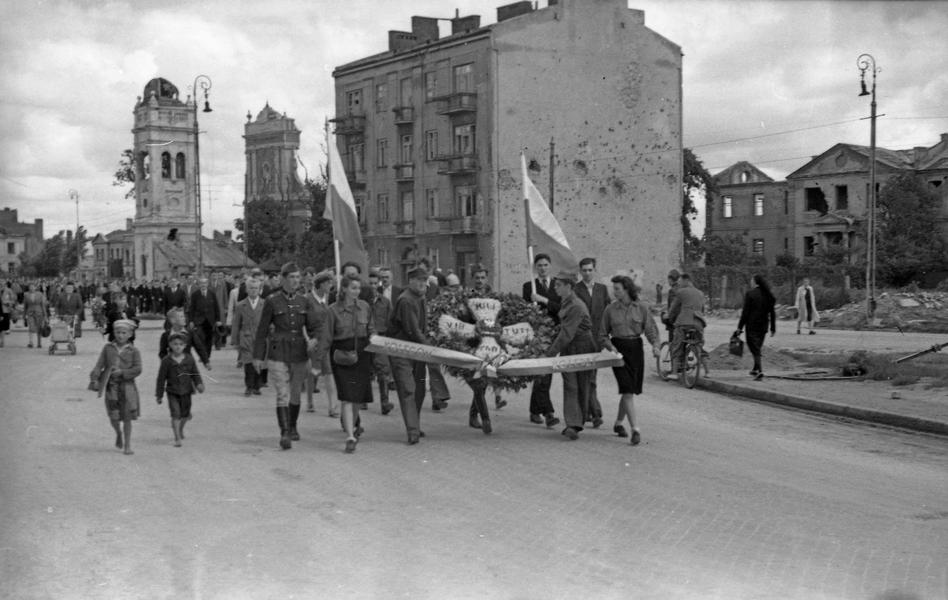 On the first anniversary of the outbreak of the Uprising, in addition to the official celebrations, there were also ceremonies organized by the insurgents; the procession with the wreath heads towards the collective grave in Dreszer Park in Warsaw. © R. Witkowski (Archive of the Warsaw Uprising Museum)
On the first anniversary of the outbreak of the Uprising, in addition to the official celebrations, there were also ceremonies organized by the insurgents; the procession with the wreath heads towards the collective grave in Dreszer Park in Warsaw. © R. Witkowski (Archive of the Warsaw Uprising Museum)After the cruel experiences of German and Soviet occupation, Poles seemed to be perfectly aware about the true intentions of the Soviets. They were also conscious that the Red Army, coming to the country from the East, was not fighting to guarantee Poland’s freedom; instead; it sought to transform Nazi totalitarianism into its own, communist, one. The battle, taken by Poles on August 1, 1944, aimed to liberate the country’s capital and to welcome Soviet troops as their new hosts, constituted the very last attempt to save Poland from enslavement. However, the Poles were to pay a huge price for this decision. Nearly 120,000-150,000 residents of the capital were killed while those who managed to survive were driven out of a city that almost completely disappeared from the face of the earth. As a result of the fighting, one quarter of the city’s buildings was destroyed. Another 30 percent of buildings were demolished after the end of Warsaw Uprising.
It was at the same moment when the Polish Underground State, which had been active for five years in secrecy, took up the fight in Warsaw; a Moscow-controlled Polish Committee of National Liberation had already been operating in the city of Lublin. Control over the country was soon taken by an illegal government. The communists would have absolute power in Poland for the next 45 years; the then leaders falsified the memory of the Uprising by imposing their own untruthful narratives of the event: the fact of revealing the truth about the Uprising would also unveil that they had absolutely no legitimacy to govern.
Both insurgents and soldiers of the underground Home Army (Armia Krajowa, AK), were treated with hostility in a communist-ruled country; they were referred to as “spit-drenched dwarf of reaction” and enemies of the “people’s homeland”. They became victims of persecution, arrests and even murder – committed under the majesty of communist law. This intensified after 1948 and continued uninterrupted until the mid-1950s. Poland’s communist authorities charged them with absurd accusations of anti-state activities whose aim was supposedly to overthrow the then government as well as of conducting spying activities for foreign powers and collaborating with the German occupier. It was only after the death of Joseph Stalin and some changes that occurred within the communist party that such sharp criticism of the Uprising began to gradually liberalize: political prisoners, including a large group of Home Army soldiers and insurgents, were released from penitentiaries. However, up until the very end of communist rule in Poland, the authorities perceived the memory of the Warsaw Uprising in terms of an uncomfortable, and even dangerous, uncomfortable truth that could unite members of society and uphold their resistance to the rulers.
Appropriating Memory
From the very beginning, the communist authorities had the intention of imposing an organizational framework on the celebration of Warsaw Uprising anniversaries; the leaders counteracted any social initiative and thoroughly controlled the content of every speech. In his address delivered before the communist parliament just a few days before the first anniversary, First Secretary of the Polish Workers’ Party Władysław Gomulka set an ideological framework on the appropriate manner of speaking and writing about the Warsaw Uprising; he divided the insurgents between heroic soldiers and cynical, almost criminal, commanders. Since that time, while such interpretation had been slightly modified, it was still in force until the fall of communism in Poland in 1989. At the same time, the communist government had been systematically creating the myth of the People’s Army – an armed formation of the Polish Workers’ Party subordinated to command centres in the Soviet Union – as the main insurgent force fighting against the German occupier. spit-drenched dwarf of reaction.
Both the first and second anniversary of the Warsaw Uprising was celebrated by the country’s authorities: state celebrations and numerous religious services were held while the main remembrance ceremonies were organised in Powązki Military Cemetery in Warsaw. A few days before the first anniversary of the Warsaw Uprising, Warsaw scouts decorated the walls and sidewalks of the capital with the following inscription: “Glory to the Heroes of the Warsaw Uprising, August 1, 1944 – August 1, 1945”. The second anniversary was marked by the unveiling of the Gloria Victis Memorial (“Glory to the vanquished”) in Powązki Cemetery; the statue commemorated soldiers of the Home Army who were killed during the Warsaw Uprising and German occupation. Thanks to the efforts of the Home Army soldiers, it was erected in memory of the Uprising, next to the graves of the insurgents.
The communists limited the third and the fourth anniversary to ceremonies taking place exclusively in cemeteries and churches. In the period 1949–1953, during the intensified struggle against the “class enemy”, they even prevented Poles from paying tribute to the fallen insurgents in Powązki Military Cemetery.
In 1949, the Society of Fighters for Freedom and Democracy (Związek Bojowników o Wolność i Demokrację, ZBoWiD) was established; the organization brought together 11 social institutions but, interestingly, it did not include former Home Army soldiers. It was only after 1954 that their members began to be partially rehabilitated. Many soldiers of the Home Army, as well as participants of the Uprising, joined the ZBoWiD. The celebration was restored on the tenth anniversary of the Uprising – after many years of silence. The commemoration ceremony took place in Powązki Cemetery with the participation of the guard of honor of the Polish Army. Nonetheless, all events took place under strict control of the communists.
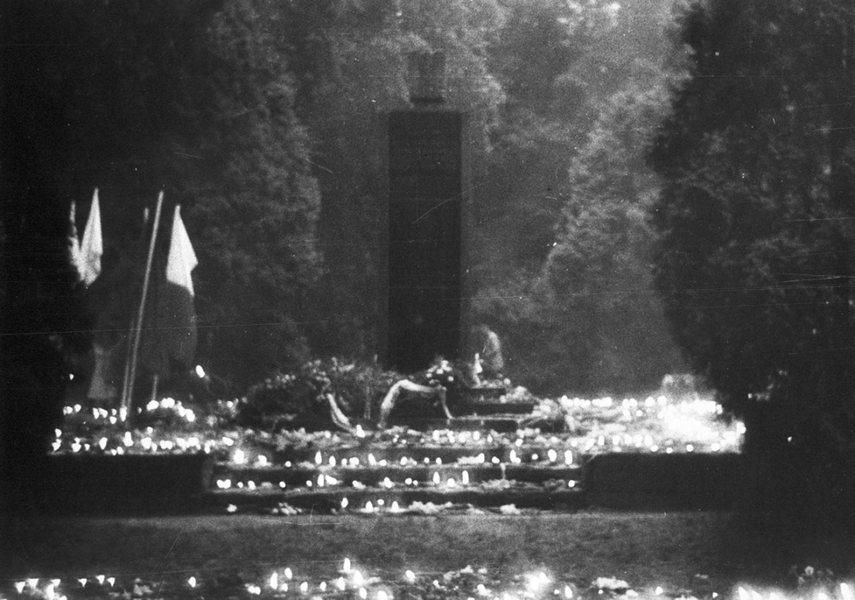 “The Monument of the Home Army”, known as “Gloria Victis”, was unveiled on 1 August 1946 at the Powązki Military Station; since then, on every anniversary of the outbreak of the Warsaw Uprising, the inhabitants of the capital have paid tribute to its soldiers. © Unknown author (Archive of the Warsaw Uprising Museum)
“The Monument of the Home Army”, known as “Gloria Victis”, was unveiled on 1 August 1946 at the Powązki Military Station; since then, on every anniversary of the outbreak of the Warsaw Uprising, the inhabitants of the capital have paid tribute to its soldiers. © Unknown author (Archive of the Warsaw Uprising Museum)After a temporary “thaw” in 1957, the authorities again sought to marginalize the anniversary celebrations. They were disturbed by any form of commemoration that would distort the framework adopted by the ZBoWiD association. In the 1960s and 1970s, the authorities continued to conduct activities aimed at maintaining the local character of ceremonies. In the 1980s, annual meetings at the graves of the insurgents became an occasion to demonstrate support for the Solidarity labor union (Solidarność), outlawed by the communists. Poles, who remembered the immense price Warsaw paid for the Uprising, were tending to manifest peaceful forms of resistance against the dictatorship.
Fight against Censorship
The political situation in the country after 1945 was not favourable to conducting any reliable research on the Warsaw Uprising. In Poland, apart from clandestine publications, there were also much smaller legal studies that depicted the event from the communist point of view. The state propagandists falsely portrayed this part of history by distorting and omitting some facts. Among the materials produced was their flagship booklet – Powstanie Warszawskie. Fakty i dokumenty [Warsaw Uprising. Facts and documents] – published in the autumn of 1944 by the Department of Propaganda of the Main Political and Educational Board of the Polish Army.
The bias contained in the publication was evidenced by the titles of subsequent chapters: Criminal political game; Actions to the detriment of the People’s Army; Strategy of betrayal, AK Command against the agreement with the Polish Army and the Red Army; Bór [Tadeusz Komorowski, Commander of Home Army] Bór” sold 11 000 defenders of Warsaw to Germans; and Nation condemns traitors from the AK command.
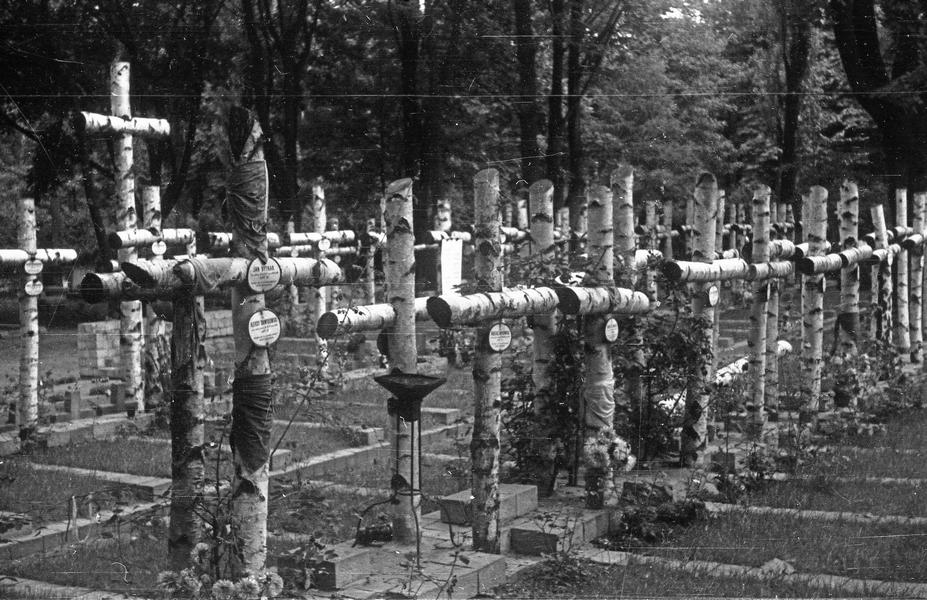 Immediately after the war, the veterans and families of the people buried in the Military Cemetery in Powązki initiated the establishment of the headquarters of the individual military units. Birch crosses on the graves of the soldiers of “Zośka” Battalion became a symbol. © J. Deczkowski (Archive of the Warsaw Uprising Museum)
Immediately after the war, the veterans and families of the people buried in the Military Cemetery in Powązki initiated the establishment of the headquarters of the individual military units. Birch crosses on the graves of the soldiers of “Zośka” Battalion became a symbol. © J. Deczkowski (Archive of the Warsaw Uprising Museum)The brochure constituted of elements of propaganda whose main purpose was to torpedo the notion of independence and to set the ideological tone for historical works on the Warsaw Uprising for a long time.
Due to the political climate in the country, it was impossible to publicly conduct reliable research. Thus, it does not come as a surprise that credible works, including memoirs and studies, were printed in exile by Poland’s high-ranking military officers and activists of the Polish Underground State, with the main actors of the Uprising: commander of its armed forces General Antoni (codename “Monter”) Chruściel (Powstanie Warszawskie [Warsaw Uprising], London 1948) and chief of the Home Army General Tadeusz (nom de guerre “Bór”) Komorowski (The Secret Army, London 1950).
Despite the unfavorable political conditions in the country, the head of the Institute of National Remembrance (transformed into the Institute of Contemporary History in 1948) opened the Warsaw Uprising archive and launched the research pending the closure of the Institution in 1950. One of his closest associates Adam Borkiewicz, colonel of the Home Army and a participant of the Warsaw Uprising, had managed to collect impressive documentary material that later became the basis of the first military monograph of the Uprising – Powstanie Warszawskie 1944. Zarys działań natury wojskowej (Warsaw 1957) [Warsaw Uprising 1944. Military outline] – published after the 1956 thaw. It was groundbreaking work: long-awaited, it immediately disappeared from the shelves of many bookstores. This year, a new edition of Borkiewicz’s book was printed by the Warsaw Uprising Museum; moreover, it was supplemented with contemporary historical knowledge.
At the expence of publications which, according to the communist authorities depicted the Uprising from unilateral perspective, the works of party historians were printed.
The real breakthrough did not take place until the late 1970s: at that time, there emerged a clandestine publishing movement whose aim was to break the party-state monopoly on knowledge and truth. The issue of the Warsaw Uprising became one of the most frequently raised in the clandestine press and in other non-official publications. Thus, Poles finally had the chance to learn about the true story of the Uprising and their leaders; one that had been hitherto ignored or falsified.
In the 1980s, the political situation in the country meant that some concessions on the authorities were imposed. The state censorship allowed the printing of many of the previously forbidden texts, memoirs and studies on the Warsaw Uprising. Despite the government’s compromise as for the manner of commemorating the Uprising, the authorities did not change their theoretical interpretation of the matter. Such issues that would be uncomfortable for communists could only be addressed in national official papers in the post-1989 era; at that time, political censorship no longer existed. It was finally possible to continue the plots that had previously been discussed either in exile or in the country (through so-called “samizdat”).
Struggle for a Monument
An almost 50-year-long struggle to erect the Warsaw Uprising monument constituted an essential element of the fight for the memory of this tragic event. The idea of its construction originated in 1945 when a fundraiser was announced as well as it was possible to hold a design contest. At the same time, there emerged a debate over the form, name and location of the memorial. At the end of 1946, the case was purposely covered up under pressure from superior authorities. Not for a long time, though. A year later, the Monument Committee was established; its honorary members included the highest representatives of the communist regime: Polish President Boleslaw Bierut and Prime Minister Jozef Cyrankiewicz. However, the communists had no intention of erecting any such monument. After the fraudulent legislative elections in 1947 and liquidation of the legal opposition, the issue of the Uprising was ignored for several years. It was not until 1956 that the idea of unveiling a monument was one again revived.
The battle for its construction took place over many years. The idea of erecting a monument returned during the years of Solidarność. At the beginning of 1981, it became possible to register the Social Committee for the Construction of the Monument to the Warsaw Uprising 1944. Thanks to a plebiscite held regarding the location of the monument, it was decided it would be erected in Plac Krasińskich (Krasiński Square), which constituted a symbolic place for the Uprising, namely where the main hatch to the sewer canals used to evacuate the insurgent units from the besieged Old Town was located.
Once martial law had been abolished, the communists made their best efforts to improve their image. On the eve of the fortieth anniversary of the Uprising, the foundation stone-laying ceremony of the Warsaw Uprising Monument was held in the presence of the First Secretary of the Polish United Workers’ Party, General Wojciech Jaruzelski. Nonetheless, the Monument could be unveiled only after the first partly-free legislative elections in Poland in 1989. The authorities managed to place the name “Warsaw Uprising 1944” on the criticized monument at the very last moment.
Restoring the Memory
It was only at the turn of the 1970s and 1980s when considerable changes, especially in social awareness, could take place. The choice of a Polish Cardinal, Karol Wojtyła, as Pope in 1978 had a significant impact on the entire process. The first pilgrimage of John Paul II to his homeland became a catalyst for a huge social movement. The papal words “do not be afraid” and “let your Spirit descend; and renew the face of the earth; of this earth!”, pronounced in June 1979 in Plac Zwycięstwa [Victory Square, now Piłsudski Square] in Warsaw, provided the Poles with strength and new energy; the sermon gave birth to the “Solidarity” social-independence movement that was created a year later. During his memorable homily delivered at Plac Zwycięstwa, the Pope made reference to the Warsaw Uprising. “It is impossible to understand this city, Warsaw, the capital of Poland, that undertook in 1944 an unequal battle against the aggressor, a battle in which it was abandoned by the allied powers, a battle in which it was buried under its own ruins — if it is not remembered that under those same ruins there was also the statue of Christ the Saviour with his cross that is in front of the church at Krakowskie Przedmieście”, he said.
Thus, there emerged a process that the communists were no longer able to stop. After several months of Solidarity’s existence, completely changed the minds of Poles and even introducing martial law in 1981 couldn’t prevent that. Polish society began to openly demand to be told the truth about the Uprising as well as to commemorate its heroes in a proper way. In 1982, the exhibition Warszawa walczy. 63 dni powstania warszawskiego [Warsaw fights. 63 days of the Warsaw Uprising] opened in the Norblin factory in Warsaw’s Wola district. It was visited by over two million people over three months. The exhibition was then displayed in other cities across the country. Then returned the idea of erecting a monument while inhabitants of the capital witnessed another important initiative – the Social Committee for Construction of the Warsaw Uprising Monument –, which was to be revived and established. However, such plans could be implemented only in post-1989 Poland.
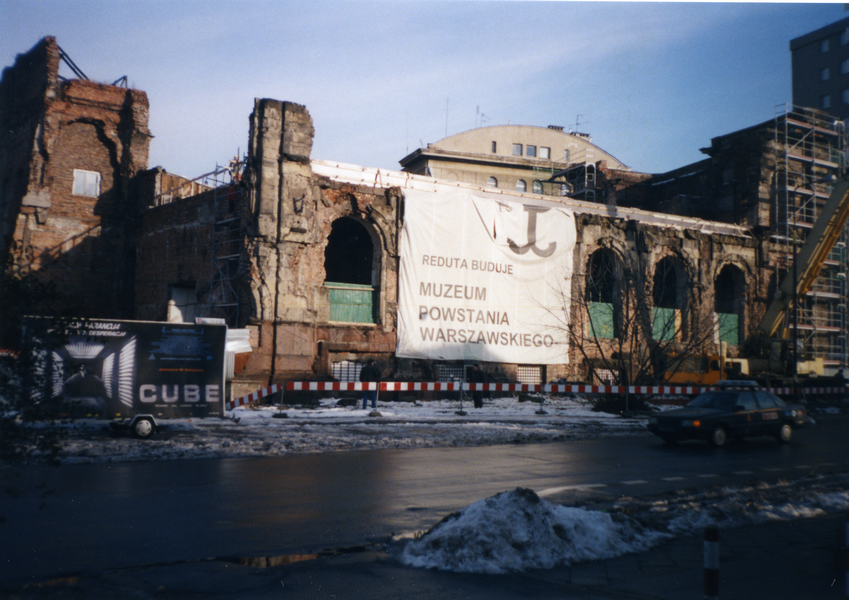 In the 1980s, a decision was made to establish the Museum of the Warsaw Uprising in the ruined building of the Polish Bank on Bielańska Street, where in 1994 the foundation act was laid; this project was not implemented. © Unknown author (Archive of the Warsaw Uprising Museum)
In the 1980s, a decision was made to establish the Museum of the Warsaw Uprising in the ruined building of the Polish Bank on Bielańska Street, where in 1994 the foundation act was laid; this project was not implemented. © Unknown author (Archive of the Warsaw Uprising Museum)Polish citizens living in the country resisted numerous manipulations of state propaganda and remembered to commemorate the Uprising. The memory of the Uprising was also alive abroad, where communities of the Polish diaspora organized their own anniversary celebrations. Even the then U.S. President Ronald Reagan proclaimed August 1, 1984 as Warsaw Uprising Day. Several days later, the highest-ranking representatives of the Washington administration met with members of the Polish diaspora in the White House. A group of invited guests included Stefan Korboński – the last person to hold the post of Government Delegate for Poland – who handed the Cross of the Home Army to the President of the United States.
Victorious memory
The opening of the Warsaw Uprising Museum constituted a groundbreaking event. The idea of its creation first appeared after the war. This idea returned several times, also again in 1981. During the following years, its originators suggested various potential locations. According to one, the museum was supposed to be placed in the building of the former Bank of Poland at Bielańska Street in Warsaw (so-called Bielańska Redoubt). Nonetheless, the project could not be implemented due to some unresolved ownership disputes. Finally, it was on the 59th anniversary of the Warsaw Uprising that the then president of the capital, Lech Kaczynski, decided to base the museum in the building of the former Tramway Power Plant in Grzybowska Street 79.
In the same year, the Warsaw Uprising Mound, located at Bartycka Street in Warsaw, was erected while at its top, next to a huge “anchor” (the emblem of the Fighting Poland), Warsaw residents inaugurated the tradition of lighting the campfire with a flame from the Tomb of the Unknown Soldiers, supposed to burn for 63 days – the symbolic period of the Uprising.
A huge role in popularising knowledge about the event was played by the book of British historian Norman Davies – Powstanie ’44 [Rising ‘44] (Cracow 2004). A few months earlier, the English edition of Rising ’44, The Battle for Warsaw was published (London 2003). Over the following months, there appeared both the American (“Rising ’44. The Battle for Warsaw, New York 2004) and the German versions (Aufstand der Verlorenen: der Kampf um Warschau 1944, Munich 2004). This publication made it possible to restore subjectivity to the armed effort of Poles in the world historiography of the Second World War. Until its publication, the issue of military activities in Poland in 1944 was usually ignored by Western historians.
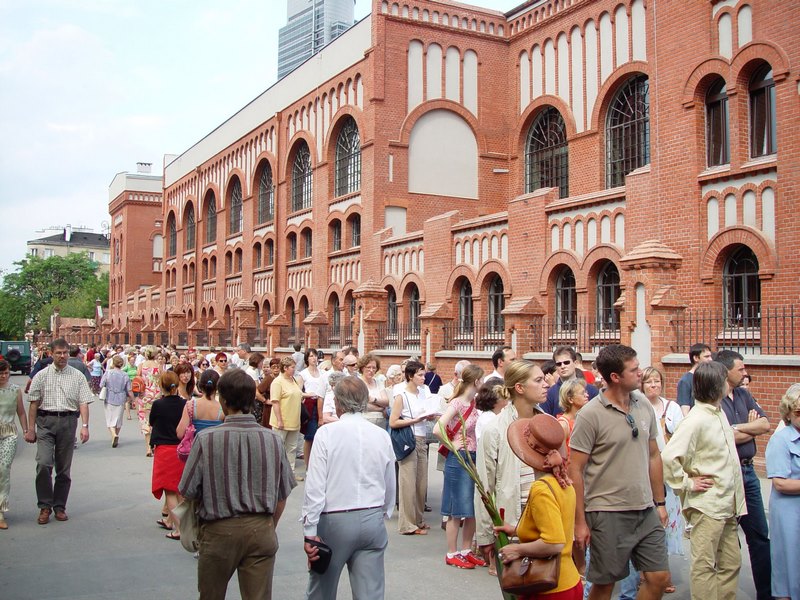 The Museum of the Warsaw Uprising was opened on the eve of the 60th anniversary of the outbreak of the Uprising. © Unknown author (Archive of the Warsaw Uprising Museum)
The Museum of the Warsaw Uprising was opened on the eve of the 60th anniversary of the outbreak of the Uprising. © Unknown author (Archive of the Warsaw Uprising Museum)Since the creation of the Warsaw Rising Museum, solemn and crowded anniversary celebrations have become a Warsaw tradition. Ceremonies are held on the eve of the outbreak of the Uprising in Krasinski Square in Warsaw, accompanied by their inherent elements: Holy Mass and Call for Remembering the Fallen. Also the aforementioned Powązki Cemetery, along with the Gloria Victis Monument, constitutes important place for the memory of the event. Every year, on August 1, it gathers thousands of Varsovians who wish to pay homage to the insurgents. For many years, exactly at 5 pm (the so-called “W” hour – codename for the beginning of the Uprising), alarm sirens are activated in Warsaw and other Polish cities while trams, cars and other means of transport stop for a moment. It is a symbolic moment of reflection and homage to the victims of the Warsaw Uprising. In the evening in Pilsudski Square, inhabitants of Warsaw sing insurgent songs.
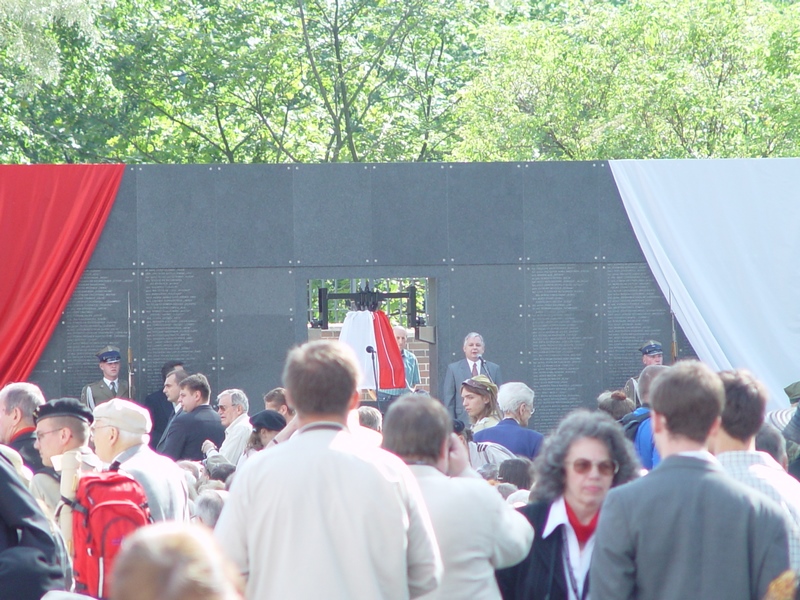 On the day of the opening of the Museum in Freedom Park the insurgents and their families took part in a meeting with the then Mayor of Warsaw Lech Kaczyński. © Unknown author (Archive of the Warsaw Uprising Museum)
On the day of the opening of the Museum in Freedom Park the insurgents and their families took part in a meeting with the then Mayor of Warsaw Lech Kaczyński. © Unknown author (Archive of the Warsaw Uprising Museum)And even though the Warsaw Uprising suffered a military defeat, its significance considerably exceeded the military sense. It was thanks to the legacy of the Warsaw Uprising and the ethos of the Home Army that it was possible to cherish the thought of freedom in the enslaved country. Although the memory of the Warsaw Uprising was fiercely opposed by communist propaganda and censorship, social awareness turned out to be stronger; it was society that managed to win the battle, which lasted nearly half a century. However, despite the communists, the Warsaw Uprising remained a symbol of love for freedom, sovereignty and sacrifice for the homeland.
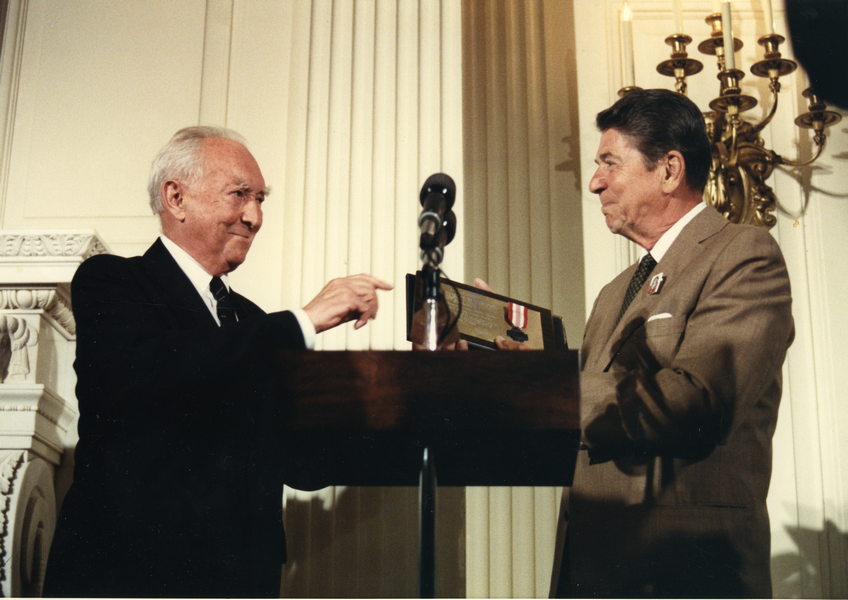 On August 17, 1984, the highest representatives of the Washington administration met with the Polish community in the White House. During the meeting, the last Polish Government Delegate to Poland, Stefan Korboński, handed the Home Army Cross to Ronald Reagan, the then U.S. President. © Unknown author (Archive of the Warsaw Uprising Museum)
On August 17, 1984, the highest representatives of the Washington administration met with the Polish community in the White House. During the meeting, the last Polish Government Delegate to Poland, Stefan Korboński, handed the Home Army Cross to Ronald Reagan, the then U.S. President. © Unknown author (Archive of the Warsaw Uprising Museum)Bibliography:
J.Z. Sawicki (2005), Bitwa o prawdę. Historia zmagań o pamięć Powstania Warszawskiego 1944–1989, Warsaw.
Z. Sawicki (2004) Najdłuższa bitwa Peerelu. Powstanie Warszawskie w propagandzie i pamięci, „Więź” 8–9 (550), 89–103.
Pyzel (1992) Bitwa o pomnik.
Spór o Powstanie. Powstanie Warszawskie w powojennej publicystyce polskiej 1945–1981, ed. by D. Gawin (Warsaw 2004).
Walka o pamięć. Władze i społeczeństwo wobec Powstania Warszawskiego 1944–1989, ed. A. Panecka (Warsaw 2008).
Powstanie Warszawskie z perspektywy półwiecza. Studia i materiały z sesji naukowej na Zamku Królewskim w Warszawie 14–15 czerwca 1994, commentary by ed. M.M. Drozdowski et al. (Warsaw 1995).
All texts published by the Warsaw Institute Foundation may be disseminated on the condition that their origin is credited. Images may not be used without permission.












